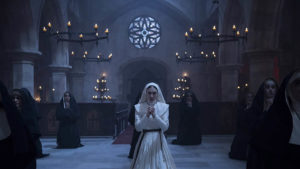Corbin Hardy’s The Nun begins with a recap of where we’ve seen The Nun (aka the demon Valak) before, most notably in Ed Warren’s (Patrick Wilson) painting in The Conjuring 2 (2016) firmly entrenching the film as another spin off in The Conjuring universe or Waniverse. In the footsteps of the franchise’s other spin offs, Annabelle (2014) and Annabelle: Creation (2017), The Nun is the newest entry based on the totally real (but not really) case files of Ed and Lorraine Warren.
Back when The Conjuring 2 came out the Nun figure caused quite a stir as its striking and eerie appearance felt right at home in the James Wan Rogues Gallery of Ghastly Ghouls but the Nun also felt slightly out of place. For a film series so indebted to the power of the Christian faith you’d think more would be made of a demonic Nun stalking the Warrens at every turn, but alas it remained a looming figure with little MO except kill the Warrens because of their innate goodness. After the film came out, Valak was a fan favourite and i09 spoke with the series director James Wan about the figure and he illuminated some of the … inconsistencies:
I had a strong outlook on the whole movie, but the one thing I wasn’t quite sure of [was the design of the demon character]. I felt like I was still discovering it. And believe it or not, I always knew that I was going to do additional photography. So I was saving it because I was hoping I’d discover what that thing would look like as I was putting the movie together in post-production.
The Nun takes place bit over two decades before the events of The Conjuring 2 and sees a young would-be-except-she-hasn’t-taken-her-final-vows nun Sister Irene (Taissa Farmiga) accompany a priest with a past Father Burke (Demián Bichir) to a remote monastery in Romania to investigate the suicide of a nun at the behest of the Vatican. Along the way they enlist a local, Frenchie (Jonas Bloquet) who discovered the Sister’s body. Once they enter the monastery all is not what it seems as Irene and Burke are tormented by visions and terrorized by the titular Nun.
Let’s just get this out of the way; (ahem) NUN of it makes sense. From the complete lack of sense of space and time in the monastery to the clunky dialogue which is only text with absolutely no subtext, there is no understanding of what the evil wants only that it is EEEEEEEEEEEEEEEEEEEEEEEEEEVIL and that EEEEEEEEEEEEEEEEEEEEEEEEEEVIL is spreading. Due to this lack of understanding the film can’t seem to establish any stakes because it can’t decide what the cause and effect of this EEEEEEEEEEEEEEEEEEEEEEEEEEVIL is. Any film which deals with elements outside of our known world (i.e the supernatural, science-fiction, Nicolas Cage etc) has to establish rules to create an internal logic an audience can follow, for instance: mysterious video + seven days later = you die. The Nun can’t settle down long enough to tell a coherent narrative because it is so intent on culling storylines from other films – Sister Irene seems to be plucked from the Maria Nunnery found in Sound of Music (1965) while Father Burke is determined to show the audience that the filmmakers have seen The Exorcist (1973).
The thing about The Nun is – it’s a drag. Outside of a couple absurdly stupid beats it’s a paint-by-numbers film that serves the most basic assumptions of what horror fans want. The capitalistic cruelness of the film stems from the fact that it will almost certainly make its money back and more at the box office and more half-hearted, warmed over jump scares will be trotted out for the sake of turning more profit from this fictional Warrens universe that began with The Conjuring. It’s notable how empty and unrefined The Nun feels since Hardy’s previous directorial effort The Hallow (2015) was a nimble, odd-ball curiosity if not totally successful. The Nun feels like it was made by a committee who didn’t even bother to show up for the first meeting.
I’d say we deserve more from this film but from the way the figure/character of the Nun was shoehorned into The Conjuring 2, it fits. The Nun was an afterthought as a character and its film companion falls prey to the same trappings.



